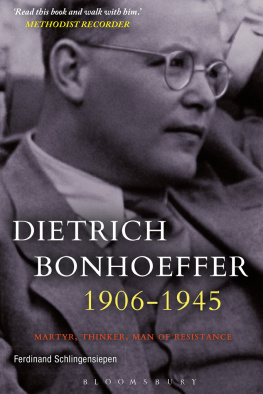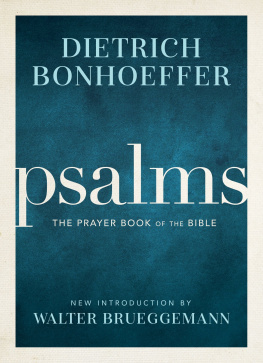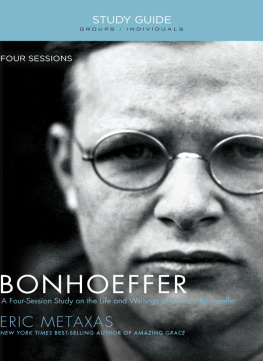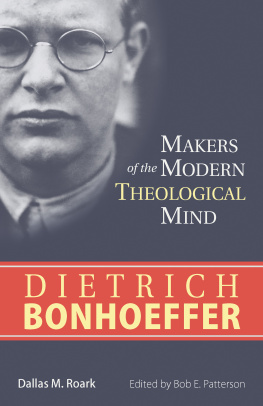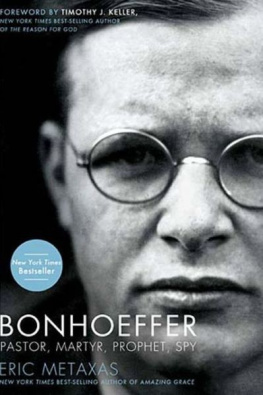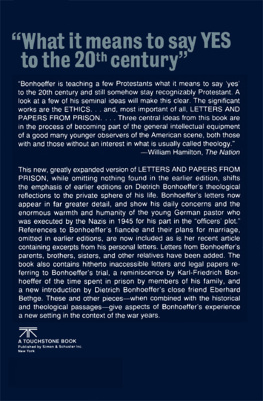LIVES OF GREAT RELIGIOUS BOOKS
Dietrich Bonhoeffers
Letters and Papers from Prison
LIVES OF GREAT RELIGIOUS BOOKS
The Tibetan Book of the Dead, Donald S. Lopez, Jr.
Dietrich Bonhoeffers Letters and Papers from Prison, Martin E. Marty Augustines Confessions, Garry Wills
FORTHCOMING :
Revelation, Bruce Chilton
The Analects of Confucius, Annping Chin and Jonathan D. Spence
The Dead Sea Scrolls, John J. Collins
The Bhagavad Gita, Richard H. Davis
Josephuss The Jewish War, Martin Goodman
The Book of Mormon, Paul Gutjahr
The Book of Genesis, Ronald S. Hendel
The Book of Job, Mark Larrimore
The Greatest Translations of All Time: The Septuagint and The Vulgate, Jack Miles
The Passover Haggadah, Vanessa Ochs
The Song of Songs, Ilana Pardes
Rumis Masnavi, Omid Safi
The I Ching, Richard J. Smith
The Yoga Sutras of Patanjali, David Gordon White
Dietrich Bonhoeffers
Letters and Papers from Prison
A BIOGRAPHY
Martin E. Marty
PRINCETON UNIVERSITY PRESS
Princeton and Oxford
Copyright 2011 by Princeton University Press
Published by Princeton University Press, 41 William Street,
Princeton, New Jersey 08540
In the United Kingdom: Princeton University Press, 6 Oxford Street,
Woodstock, Oxfordshire OX20 1TW
press.princeton.edu
All Rights Reserved
Library of Congress Cataloging-in-Publication Data
Marty, Martin E., 1928
Dietrich Bonhoeffers letters and papers from prison : a biography / Martin E. Marty.
p. cm. (Lives of great religious books)
Includes bibliographical references and index.
ISBN 978-0-691-13921-0 (hardcover : alk. paper)
1. Bonhoeffer, Dietrich, 19061945. 2. Bonhoeffer, Dietrich, 19061945. Widerstand und Ergebung. 3. Prisoners of warGermanyCorrespondence. 4. TheologiansGermanyCorrespondence. I. Title.
BX4827.B57M359 2011
230.044092dc22
[B] 2010029618
British Library Cataloging-in-Publication Data is available
Jacket photograph: Prison cell in Tegel; archival photo
This book has been composed in Garamond Premier Pro
Printed on acid-free paper.
Printed in the United States of America
10 9 8 7 6 5 4 3 2 1
To John de Gruchy and Victoria J. Barnett
and in memory of Eberhard Bethge
CONTENTS
ILLUSTRATIONS
Figure 4 is in the Ullstein Biederdienst collection; all other figures are from archival collections, now widely available
ACKNOWLEDGMENTS
John de Gruchy, Victoria J. Barnett, and Michael West made available the page proofs of volume 8 of the Dietrich Bonhoeffer Works (DBWE), Letters and Papers from Prison (Minneapolis, 2010). It was therefore possible for me to convert translations and references in my first draft, from the 1971 edition, which had become standard in the English-speaking world. That 1971 version was subtitled New Greatly Enlarged Edition, but the one being published in 2010 and referenced here is newer and more greatly enlargeddouble the size of the 1971 editionand will become and remain the new standard scholarly reference. The extensive quotations from this edition appear by permission of Fortress. I am indebted to many members of the International Bonhoeffer Society, which hosted the Martys at the Tenth. International Prague Congress in 2008, and where John Matthews, president of the English Language Section of the International Bonhoeffer Society, was our guide. I was able to converse about Bonhoeffer and the subject of this book with veterans in the project, especially Clifford Green, chairman of the DBWE editorial board; Geffrey Kelly, a veteran, now emeritus, on the board; translators Martin Rumscheidt and Nancy Lukens; and many more. I have been reading Bonhoeffer since 1953 and writing on him on occasion since 1962, but Prague was the first time I could meet with the larger company of the custodians of Bonhoefferiana and scholars who have long influenced me. John de Gruchy, our sometime host in South Africa, did much to tutor me in the ways of interpreting the Bonhoeffer Letters and Papers, and he deserves special thanks. Two unnamed readers for Princeton University Press made valuable suggestions. Fred Appel, who invented the series of which this book is an early product, was of great help at all stages along the way. I also thank Harriet Julia Marty for her generous and loving participation in the times of travel, research, writing, and now publication.
M.E.M.
Dietrich Bonhoeffers
Letters and Papers from Prison
A BIOGRAPHY
The Birth of a Book
CHAPTER 1
An old photograph provides a glimpse into a dismal cell at a Nazi prison called Tegel. Wan light falls in from a tiny window that is too high for a prisoner to use to take in a landscape, but one who is alert and sensitive might glimpse the upper branches of a high tree or a low hanging cloud, and through that opening, hear a thrush. A standard-issue plank bed with a blanket drawn tight over it takes up most of the small space in the cell and in the picture, and a board to which one could attach notices is on the unadorned wall. Other furnishings are sparse. We know from other sources than the photograph of the presence of a nearby stool and a bucket, positioned for we-all-know-what. Guards, who were forbidden to talk to prisoners, could peer in through a slot in the door to view the inmate, who could not see out. Visitors today can still imagine something of what it must have been like for a captive to squirm or pace in its ten-foot by seven-foot floor space.
All the senses can come into play during such imagining. For instance, the odor of the whole third floor in which this cell 92 stood, the prisoners pen for a year and a half, was barely endurable. No smell of fresh soap offered a contrast that could render the atmosphere slightly bearable, because there was not any soap available that could have helped make living with ones own odors less than dreadful.
The Birthplace of the Book
From that cramped space designed to kill creativity and bury hope, however, there issued letters and papers that became the substance of one of the great testimonial books of the twentieth century. Since there is so little to observe in the shadowed picture of this room, we are left other reminders and, later, his words written there, to fill it in with a human portrait, that of the author. He was Dietrich Bonhoeffer, the best-known German Protestant pastor, who resisted Hitler and paid for his actions and expressions with his life. He was a man of many paradoxes: a long-time pacifist, something that Lutherans were not supposed to be; an inconsistent pacifist who became a conspirator in an assassination plot against Adolf Hitler; a thinker who took citizenship seriously but technically was guilty of treason; a still young world traveler who did his most memorable work in this cramping cell.
We learn that, instead of killing himself, he began to write, especially as his material circumstances eventually, if only slightly, improved. Many of his notes, of course, were personal letters, some passed on through authorities and some smuggled out and then transmitted to his best friend, Pastor Eberhard Bethge, who saved them. No publisher would have seen a potentially attractive book in the letters or his other various jottings, musings, and poems written in prison.



